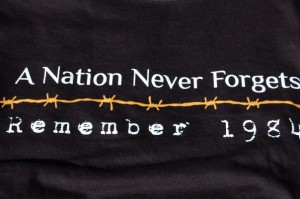
Guest blogged by Dilpreet Kaur
Mere days before Osama bin Laden’s capture and death, the Arizona state legislature had set into motion legislative steps to remove a 9/11 hate crime victim’s name from the state’s memorial in Phoenix. At the time, the bill’s original sponsor, Rep. John Kavanaugh (R), claimed that Mr. Balbir Singh Sodhi was “not a victim of 9/11.” Adding insult to injury, along with stripping the late Mr. Sodhi’s name from the memorial, the legislation even enumerated that the removed plaque to be sold to a scrap metal dealer.
Like many others who stumbled across the news of this puzzling piece of legislation, I instantly wondered how and why something so insensitive and outrageous could pass. Four days after 9/11, on September 15, 2001, Balbir Singh Sodhi, a Sikh American, was brutally murdered outside of his Chevron gas station in Mesa, Arizona by Frank Roque, a man who wanted to ‘kill a Muslim’ in retaliation for the terrorist attacks. He had selected Mr. Sodhi simply because he had a beard and wore a turban in accordance with his Sikh faith. An Arizona jury later found Frank Roque guilty of first-degree murder for his hate crime murder of Mr. Sodhi, along with five other charges, including attempted murder and reckless endangerment related to drive-by shootings at other individuals he perceived to be Middle Eastern that same day in 2001.
Balbir Singh Sodhi was the first of hundreds of hate-crimes against Sikh Americans and other minorities related to post-9/11 hate violence. His death as a Sikh American brought national attention to the issue of anti-Muslim and anti-Arab violence following 9/11. At the time, many Arizona state representatives and citizens of all backgrounds rallied around the Sodhi family and the Sikh American community in support, with over 3,000 people attending Mr. Sodhi’s memorial service.
As the Sikh community in Sacramento continues to grieve the losses of hate crime victims Surinder Singh and Gurmej Singh Atwal who were gunned down earlier this Spring (with no suspects still), the Sacramento Sikh Temple has truly embodied the Sikh spirit of sarbat da bhala this past week, extending a hand of solidarity to the gay community.
The Sacramento Sikh Temple is offering a reward of $1,000 for information leading to the arrest and conviction of the perpetrator of a violent hate attack on 26-year-old Seth Parker, who believes he was beaten because he is gay in the parking lot of the Strikes Family Entertainment Center in Elk Grove (the same area with Singh and Atwal were shot). Parker was punched in the face, suffering multiple facial fractures, while the attackers directed homophobic slurs at him.
A spokesperson for the gurdwara stated: “The Sikh Community condemns this disgusting attack motivated by ignorance and hate. In light of the recent murders of two Sikhs in Elk Grove and the hate crime conviction in Yolo County (of two men who attacked a Sikh taxi driver), we are especially sensitive to such crimes. We hope that our reward will help bring these criminals to justice.”
A few years ago I was putting up some flyers on street poles and bulletin boards in Williamsburg, Brooklyn promoting an upcoming concert for my band. If you’re from New York City, you know Williamsburg is a neighborhood covered with concert flyers and band logos, and the home of dozens of music venues filled with indie rock-loving, skinny jeans-wearing hipsters (for the record, this has nothing to do with me nor my old band).
After a few minutes of putting up a bunch of flyers with tape, I was suddenly surrounded by 4 police cars and their flashing sirens. One of the cops approached me, while the others stayed close behind. He had one of our flyers in his hand and asked if I put it up. I said yes. He informed me this was “graffiti” and was illegal. I apologized and said I was not aware of that. He took my ID, talked to his colleagues, and the next thing I know I’m being aggressively handcuffed and put into the back of a police car without any explanation.
To make a long story short, I was arrested because a few years prior to the flyering incident, I got stopped and cited for riding my bicycle for a few feet on a sidewalk (in the rain) and never appeared in court for this egregious violation of the law and disturbance to the peace.
But this isn’t a story about why I got arrested and how ludicrous it is that these cops arrested me rather than asking me to please not put up flyers on street poles (which were already covered with flyers). This isn’t a story about racial or religious profiling and about if these (white) cops were driven by bias or if they were paying special attention to a turbaned, bearded brown man walking down a gentrified, newly predominantly white hipster block of Brooklyn.
This is a story about incarceration.
When I was taken to the precinct, still not knowing why I was arrested or what the hell was going on, I was aggressively and invasively patted down (more like groped) and searched by the officer who arrested me. After a few conversations with other officers at the precinct, I started putting the pieces together in my head as to why I was arrested, and they assured me that I’d be out of there in a few hours. I felt a bit relieved, though still anxious. I was hopeful that I could keep my head up and make it through this with my self-respect and dignity in tact.

Crowdsourcing has its uses. Here is one.
This year the Jakara Movement is celebrating its 12th annual Lalkaar Conference with the theme Kaur Voices: Exalt, Express, Empower. Hosted in Sacramento this week, June 16-19, 2011 – I am sure the conference will be a success.
The email I received announcing this contest, reminded me about when I attended this conference on the same theme 5 years ago. Back then, we brainstormed about the need to create creative ‘community-solutions’ to problems in our community, like sex-selective abortion. The idea for Ladoos: Pink and Blue was born. Now 5 years later, they are making it a reality.
The guidelines to the competition are easy:
We aim to create a gift box that would include health-related brochures, inspirational Sikh literature, and a number of “Sikh Baby Firsts” – a kara, a gutka, a bib (proclaiming a proud new Singh and Kaur), and many other Sikh-inspired items. The decorative box will serve as a keepsake that will be found in the homes of all Sikhs and to be kept and cherished for years to come.
The winner will receive a $100 Visa Gift Card as well as the satisfaction of seeing their creation in the homes of all Sikhs, in a celebration of equality.
Please submit by July 15, 2011.
Submissions should be created using Adobe Illustrator. We will take submissions in other programs, but highly recommend Illustrator. If using Photoshop, please make sure to use minimum 300dpi. Hand drawn/scanned submissions will also be considered.
Please remember you have to design all sides (top, left, right, back, front panels)
As I can’t draw, if my life depended on it, I look forward to seeing all of your submissions and to the future of this project. I will keep you posted!
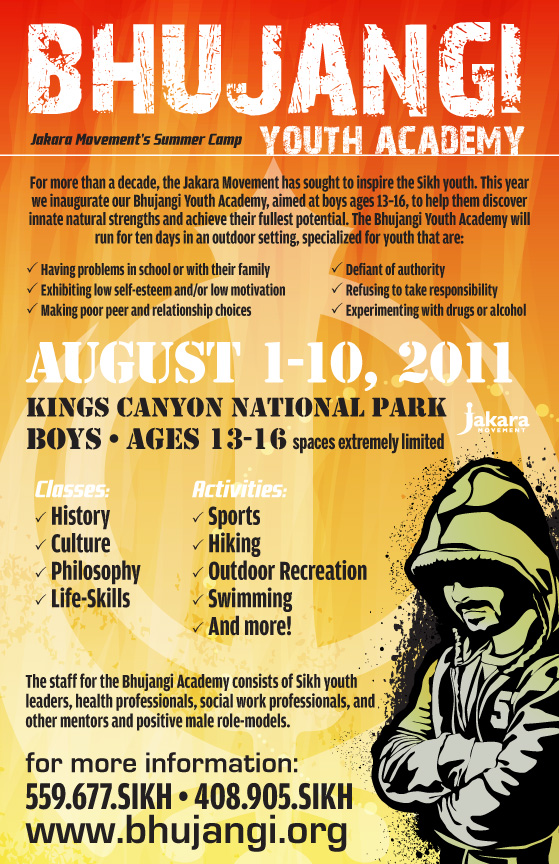 Do you know a young boy, ages 13-16 that may have:
Do you know a young boy, ages 13-16 that may have:
- problems in school or with family
- exhibiting low self-esteem or low motivation
- making poor peer and relationship choices
- defiant of authority
- refusing to take responsibility
- experimenting with drugs and alcohol
Maybe some of this describes your nephew, maybe a cousin, maybe a brother, maybe even a son.
There is a unique opportunity for them. It is a first in our community.
We have long heard about the problems of Punjabi masculinity, anger problems, substance abuse that are facts in our community. The cases in Surrey are the most well-known and documented.
We need community solutions. Here is one. The Jakara Movement is attempting to reach out to young boys, before these problems become truly manifest. For the first time, they are conducting the Bhujangi Youth Academy from August 1-10, 2011 in the Kings Canyon National Park, California.
The camp will consist of classes, outdoor adventures, fitness, and fun in a Gurmat environment.
The website is still being developed, but they are looking for both PARTICIPANTS and VOLUNTEERS for this unique experience.
There are LIMITED spots open for participants. Look at the details and APPLY NOW! (before 6/24/2011)
If you seek to be a member of the staff – maybe you have reclaimed your life, maybe you enjoy working with the youth, maybe you have a passion for the cause. Then APPLY NOW! (before 6/22/2011).
Please help circulate this widely – send it to listserves, post on your FB, tweet it for us. Help us get out the word!
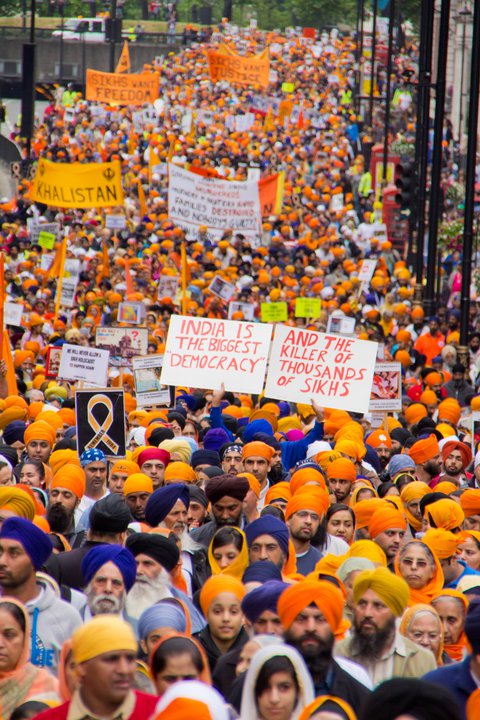 You can repeat your lies….This one comes from the Times of India:
You can repeat your lies….This one comes from the Times of India:
The organisers claimed a figure of 25,000, but the Scotland Yard put the number at 6,000. The ‘Remembrance March’ began at Hyde Park and concluded at Trafalgar Square.[link]
But the truth will get out and you will look all the more stupid for it. Does this look like 6,000? Seems much closer to the 25-35K that was claimed. Sikhs have not forgotten. Until there is justice, Sikhs will never forget.
We will strive for justice for the innocent, such as Professor Bhullar (Watch this powerful video from the WSO’s Annual Parliamentary Dinner; on Professor Bhullar cue to 23:40); we will strive for justice against the guilty.
We live in Bakersfield; we live in Brampton; we live in Birmingham. We still yearn for Bathinda. Our brothers and sisters in London showed it this weekend. Let our brothers and sisters in Punjab know that we are still connected; we will still raise our voices; we still remember.
In Toronto, Lions will roar. A Nation Never Forgets.
Today we remember twenty seven years since June 1984.
We remember twenty seven years since Indira Gandhi sent the Indian Army tanks and artillery to the Darbar Sahib Complex and forty one Gurdwaras across Punjab on the shaheedpurab of Guru Arjan Dev Ji.
We remember twenty seven years since bodies lined the hot marble of the parkarma. Though Government reports indicate 493 civilian deaths and 83 army casualties, eyewitness accounts suggest the numbers were much higher since 10,000 pilgrims and 1300 workers were unable to flee the Darbar Sahib complex on this day.
We remember twenty seven years since books, manuscripts and other documents have been reported missing from the Sikh Reference Library numbering 10,534. The library which was intact on June 6th had been burnt down by June 14th. In April 2004, many of these writings, which included handwritten manuscripts were reported to be in the hands of the Union Government where they remain today.
We remember twenty seven years since the events that spurred the November 1984 pogroms and the government lead counter-insurgency in Punjab which left a generation of 25,000 missing.
We remember twenty seven years since Sikh women (and men) learned too well that coercion does not just come from tanks and artillery – that sexual violence can be a systematic and deliberate weapon of the State.
We remember twenty seven years since Punjab was left a political climate that hid the state’s impending agrarian crisis and its interrelated manifestations of farmer suicides, drug addiction and gendercide, even when reports as early as the 1985 Johl Report warned that the farming sector was faltering and the real need to diversify crops from the standard wheat-paddy rotation.
We remember the impact this had on the Sikh Diaspora, the communities New York, California and Canada, and the tireless nights many of our fathers and mothers spent out, mobilizing themselves even as recent immigrants with young daughters and sons.
We are a community that is well versed in Remembrance.
According to Urban Dictionary (is there another source?), “The single most manly, and great thing a man can do [is grow a beard]. To have a beard is to be a true man. If you have a beard, show it off proudly, and enjoy the satisfaction of the envy in the eyes of people around you who don’t have beards. If you don’t have a beard, grow one.”
Well, that’s that. What could be a better way to start the weekend than a montage of beautiful beards and the rhymes of Jose Gonzalez?
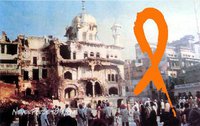
6/4 @ 2:15pm – More tweets by Panjabi MC, award-winning MC Amrit Tung, even hiphop artist B-Magic. Also pagh salute to our friends at Naujawani for keeping us up to date with their twitter feeds.
6/3 @ 4:45am – Since the post went up, Bhangra Star Jassi Sidhu, famed DJ Bobby Friction, Gurdarshan Mangat (Saintlion), and Raxstar. Keep the list growing!
So as they say, it starts with an idea. This one comes from Simrat Kaur from the Bay Area. Sometimes, it happens even on the BART.
It was an idea to increase awareness all over the world of the events that unfolded during Operation Blue Star in 1984. If people from the Middle East can use sites such as Twitter to start revolutions, then why not Sikhs? We need to stop using social networking sites for the purposes of hitting on girls and flirting with guys. We need to start a revolution. How long will Sikhs stay quiet? I am one hundred percent sure that if the same attack had been carried out on the holiest of places of any other religion, things would have definitely not ended this way.[link]
The challenge is simple and symbolic. We have not forgotten. Without justice, there can be no forgetting. So here is what we are asking. Use your twitter or start an account – but tweet the following #neverforget84 everyday and all day from Jun 3rd to the 6th. Here is the event page on Facebook. The goal is to get #neverforget84 to trend. Is it slacktivism, maybe….but can it have real ramifications, maybe…..
The Jakara Movement is participating so you can follow them too at @jakaramovement . At the time of this posting, even bhangra sensation Jassi Sidhu has tweeted #neverforget84 . With some encouragement, maybe even Jay Sean, Gurbaksh Chahal, and others will follow. Do your part! Tweet! and ask for favors from friends/family/people you are following!
Also for some general information about Sikhs and 1984 – follow this link.
Hope to see your tweet!
Guest blogged by Adi Shakti Kaur
For as long as I can remember, I can envision the imprints of patriarchy within the Guruduaras (Sikh spaces of worship). The Guru, was more than sacred scriptures; more than a living embodiment of the ‘word’; more than a Guru, who took us from darkness to light; but a portal for us to connect to our own Divinity, a genderless form that was beyond the simple, human constructions of defining, labeling and understanding. But in the Guru’s Darbar (court of the Guru), it was brimming with gendered representations. The examples of patriarchy in Guruduaras are monolithic – every role in the Guru Darbar is dominated by men, from the giving of prashad to the katha vichar. Sikhi emerged out of a cultural, political, economic and social period that privileged the masculine gender, and of course patriarchy (as well as other hierarchical constructions).
The revolutionary stance that Sikhi took on the existing beliefs challenged all aspects of the zeitgeist during the Guru period. I articulate this now as a grown woman who has had the honour of a lifelong relationship with Sikhi, with Sikh institutions and with Sikhs, and who also has had the privilege of critically engaging in the world around her, particularly through her academic pursuits. In most Guruduaras, I have had the sacred opportunity to enter, I have been greeted by scenes staged with men occupying the privileged positions in the Guru Darbar, in the langar hall and in seva roles. When the stage is constantly set with masculine representations of Sikhs, from the physical men before me to the Gurus who established and nurtured Sikhi into its current status as a world religion, I never really considered that there was an institutional space for me, for my sister, for my mother, and any Sikh woman to occupy. And for many Sikh women that male privilege extends into their homes and extended families (thankfully there are anomalies like my parents).
As I delved further into Sikhi, I saw an opening for my feminine identity. The Gurus, starting with Guru Nanak Dev Ji, not only placed value in my sex and gendered identity, but honoured us with our everpresent Kaur title. The cultural, economic, political, and social backdrop is still patriarchy, no matter how you present the egalitarian and feminist interpretations inherent in Sikh philosophy, men were privileged, men were hyper visible and that tradition continues today in the majority of Sikh institutions (including the Guruduaras) and communities. Now that I am far removed from my childhood naïve absorption of the Sikh spaces around me, absorbing the patriarchy of my spiritual space, how do I carve out the egalitarian and feminist standpoints as a grown woman, as a mother to my daughter, so Kaurs can begin to chip away at the institutionalized patriarchal vantage position given to the masculine?
 Call me a hater, but I am just not that excited. Despite the exuberance of some of my fellow langa(w)riters, I am not convinced.
Call me a hater, but I am just not that excited. Despite the exuberance of some of my fellow langa(w)riters, I am not convinced.
Don’t get me wrong, one of the worst leeches that have siphoned the blood, resources, and morale of the Panth for far too long is the Family Badal.
While state coffers are in ruins and the once mighty land of five rivers finds itself facing ecological (decreasing water table and poisoned through pesticides) and social disasters (drugs and sex-selective abortion, immediately come to mind), the upcoming 2012 elections will be the most expensive show-down in the state’s history. With the anti-incumbency trend so powerful (nobody ever explores this phenomenon, but it is the travesty of Punjab, where you kick the ruling party out, not too support the opposition, but merely hoping for a ‘slight’ improvement), most are predicting a Congress victory.
In no small part this will be due to in-fighting within the ruling Shiromani Akali Dal. As Parkash Badal has turned the once Panthic Shiromani Akali Dal into a “Punjabi party” that is really nothing more than his own fiefdom for his patronage networks, public disapproval is on the rise. The people in Punjab are asking if their situation has improved over the past 5 years. Increasingly, they are saying no.
The greatest hope (or hype) about the upcoming elections is seen in Manpreet Badal’s Punjab People’s Party. Manpreet (Parkash Badal’s nephew) was thrown out of the party due to taking openly critical positions. Many youth are energized, as they see the PPP as a step towards a new future. Even in the diaspora, people (including my own father!) are excited, as I haven’t seen in years.
Ummm, take the title, however you like….
While we often rely on Maple Leaf Sikh to keep us up to date on the happenings in the land up North (Canada!!), this information is brought to you (and us) by another (pagh salute: JusReign).
While Russell Peters needs no introduction in the diaspora due to his comedic talents, those of us a little bit older remember him from his DJ days during the modern birth of contemporary bhangra music.
Here he comes in an interesting new movie, Breakaway. It seems everyone’s favorite (well, not mine – Bhagwant Mann gets that title) Gurpreet Ghuggi will have a role. Do you think you’ll go watch Breakaway?

Last week marked the 63rd anniversary of the Nakba, meaning catastrophe, when a n estimated 700,000 Palestinians were displaced from their homes with the establishment of the state of Israel in 1948. I, and others, have argued elsewhere why the Palestinian struggle for freedom and self-determination is relevant for us as Sikhs, so I won’t reiterate that here (see Sikh Solidarity with Palestine statement).
n estimated 700,000 Palestinians were displaced from their homes with the establishment of the state of Israel in 1948. I, and others, have argued elsewhere why the Palestinian struggle for freedom and self-determination is relevant for us as Sikhs, so I won’t reiterate that here (see Sikh Solidarity with Palestine statement).
Every year Palestinians and their supporters commemorate the Nakba by holding demonstrations, vigils, and educational events. This year saw unprecedented resistance by Palestinians in the Middle East, who mobilized at numerous points across Israel’s borders. Their resistance to occupation and their commemoration of one catastrophe was met with with violent repression by Israeli forces — catastrophe upon catastrophe. 14 Palestinians were killed and hundreds more injured as Israeli troops fired on the massive protests.
In an interview on Democracy Now last week, Fadi Quran, one of the protest organizers stated:
…we, as a youth movement, called for the protest because, as many of you know, there are about seven million Palestinian refugees who just want to go home, and they’ve been unable to go home for the last 63 years. So at the protest, initially what you had is a lot of people who are my generation, 23 years old, carrying or wheeling their grandparents to the border so that they can finally take them back and they can return to a normal life, where they are free, where they live justly, and where they can pursue happiness.
UPDATED 5/23/11: This post has garnered renewed attention after the recent murder of Balbir Dhami. The Sacramento police does not believe it is a hate-crime and do to the circumstances, most in the community do not believe so either. I won’t make speculations, but will leave it to the law enforcement officials to sort out the case.
Earlier this week, the Drug Enforcement Agency (DEA) sent their agents to capture an Elk Grove man.
Balbir Dhami 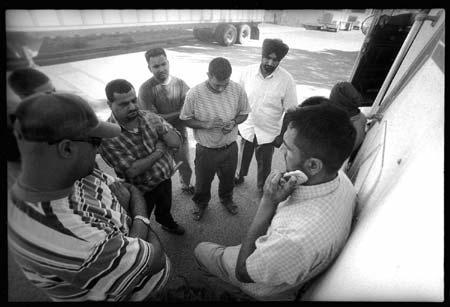 [click on the link to see the news video], the owner of Dhami Trucking Plaza on Stockton Blvd in Elk Grove, was arrested and is accused of being at the center of a drug running business, moving marijuana and cocaine, between Canada, Elk Grove, and Los Angeles.
[click on the link to see the news video], the owner of Dhami Trucking Plaza on Stockton Blvd in Elk Grove, was arrested and is accused of being at the center of a drug running business, moving marijuana and cocaine, between Canada, Elk Grove, and Los Angeles.
The news describes Dhami as a “prominent Elk Grove business man and leader in the Sikh community.” While I don’t know if he was a prominent business man or even a leader in the Sikh community, from internet searches, he does seem to have made political overtures as campaign finance records show that he donated to Democrat Dick Gephardt’s presidential campaign in early 2004.
His family has denied his involvement:
“I know my dad. What he’s being blamed for in the allegations it’s totally against our religion. It’s something he’s against and wouldn’t recommend anyone else to do something like that,” explains Aman Dhami [Balbir’s son]. [link]
While I cannot speak on Dhami’s specific case, I can speak about this being a common problem within the Punjabi Sikh community.
Today marks the 86th birthday of the late African American activist Malcolm X. We’ve been hearing a lot about Malcolm X lately since the recent release of a new biography about him written by the great scholar Manning Marable, who just passed away a few weeks ago.
A controversial and often misunderstood historical figure, Malcolm X was a Muslim and saw his faith in God as inextricably tied to his relentless fight against racism and injustice. At the end of the day, it all came back to human rights. We Sikhs know the long struggle for human rights all too well, and I for one take inspiration from this fearless leader who tragically lost his life at the age of 39 in his fight for human rights and dignity.

Guest blogged by Satvinder Kaur Dhaliwal
Admin Note: After completing her undergraduate studies in Anthropology, the author traveled to Panjab to volunteer. She spent her time volunteering at Pingalwara and working with the Baba Nanak Education Society (BNES). Below is an article she wrote for BNES to raise awareness about their impactful work addressing farmer suicides.
::
Village Barlan, District Sangrur, located near the Panjab-Haryana border, depicts the prosperous, joyful Panjab that many of us are eager to visit. Roads leading to the village are surrounded by what appearsto be flourishing farmland, stretching as far as one can see. Children have returned from school and are laughing and chasing each other through the streets of the village, the elderly have gathered to discuss recent happenings, and women can be seen carrying various necessities to their homes. This first glance overview of Balran disguises a harsh reality that a growing number of households in the village are facing – suicide.
Suicide is an equal opportunity visitor in Balran and many other villages throughout Panjab. Increasing farming costs, the removal of farmers’ subsidies, and low rates for crops are putting Panjab’s farmers in a never-ending cycle of debt accumulation. Each year, farmers in Panjab face increased agricultural costs and low returns for their crops. In order to cover these costs, farmers must take out loans, which they usually get from their local aarthiya or money-lender. The aarthiya often ends up being the same individual who will buy the farmer’s crop at the mandi or market, and then re-sell the crop on the public market. Sukhjinder Singh, a farmer, described the reason for debt accumulation as, “Let’s say that I sell my crop for 11 rupees per kilogram. When I need to purchase the same crop for my home, I have to buy it for 14 rupees per kilogram. So how can we profit?” Consequently, when a farmer’s costs are constantly exceeding his profits, he must cover his costs by taking out loans. Now, he has increased his debt by introducing extremely high interest rates, which are often decided by the aarthiya.
Unlike the west, the gendered demarcations of males and females in Panjab are much more stark, and it is common for women to be unaware of their family’s financial circumstances. Therefore, when the male becomes consumed in debt and can no longer bear humiliation from the taunting money-lenders, he begins to see only one way out – suicide. His surviving family members are not only left devastated, but they must find a way to provide for themselves and pay off the debt on their family, of which they may never have been aware in the first place. Often times the surviving family members include a wife, children, and elderly parents. In winter 2011, I visited the families of various suicide victims in Balran. Some families had lost their loved one a few years ago, while some had only experienced the loss a few days ago. Although I only visited seven families, the Baba Nanak Education Society has documented 91 suicides and numerous missing individuals in Balran since 1998. Nonetheless, all family members were still grieving equally and struggling to pay off their debt.
As mentioned last month, New York City-based Vishavjit Singh released his first “Sikhtoons” book this Spring. Entitled My Headcovering is Downright Sikh: An Illustrated Intro to Turbans, the book “uses a collection of cartoons from Sikhtoons.com to create a visual narrative to dispel the mysteries of the Sikh turban. Featuring Fauja Singh, Waris Ahluwalia and many other Sikhs from all walks of life this visual journey is a turbanful introduction to Sikhs.”
The book features 30 cartoons and can be ordered online in the US, Canada, and UK for $10.
Though I have not seen the book myself yet, it has the endorsement of Sikh scholar IJ Singh, who states:
Vishavjit Singh’s topic is serious, his touch light, but not comedic. The sense of the absurd is critically important to the cartoonist. That, too, will emerge, I am sure, for I see their seeds in his work. I believe that the lightest matters deserve a serious undertone and the most heavyweight issues need some levity, even comedic treatment sometimes, lest the burden becomes too heavy to carry.
Congratulations to Vishavjit on this accomplishment. As misconceptions and stereotypes about Sikhs continue to persist in the mainstream media and general public, I hope Vishavjit’s creative cartoon interventions reach a much wider audience through this book.
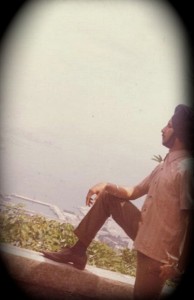 A friend of the The Langar Hall and a Sikholar in her own right has started a fascinating website, called “Sikhs Wearing Things.”
A friend of the The Langar Hall and a Sikholar in her own right has started a fascinating website, called “Sikhs Wearing Things.”
The purpose of the blog states:
sikhs wearing things around the world.
inspired by the “muslims wearing things” tumblr. this is dedicated to showing a multiplicity of sikh styles in order to repudiate the notion of a single sikh identity.
And is dedicated to her late father, a very stylish Sikh.
The goals of the site is largely in keeping with our own vision of The Langar Hall – where there is no single Sikh opinion and the Langar Hall on-line or in-life is the place where a diversity of views and ideas can be shared, debated, and considered.
Check out the site and maybe even send the blogger some of your own thoughts and pictures!
It’s been over a week now. I’ve been wanting to write, but have been on the road, my head spinning with newspa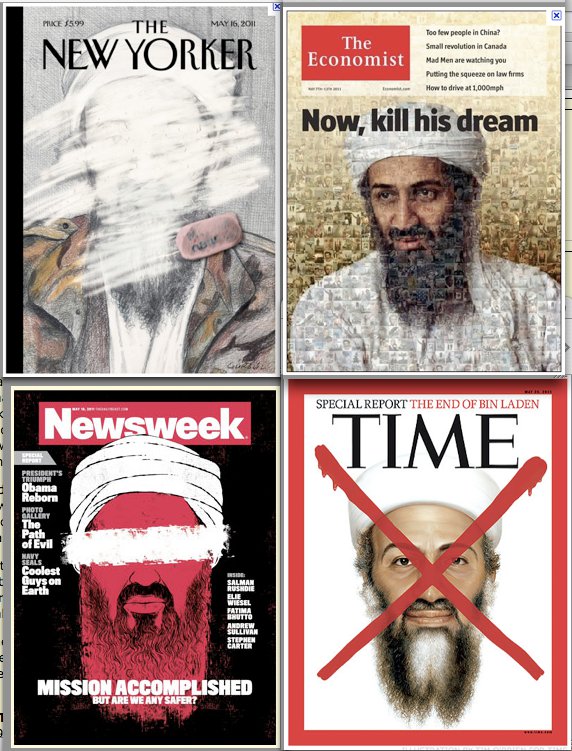 per headlines and the voices of cable news pundits. Navdeep posted some thoughtful reflections and questions here, and in the meantime, we’ve had the opportunity to see the response to bin Laden’s death throughout the country and world. By now, we are all probably well aware of the spontaneous celebrations of thousands at Ground Zero and Time Square in New York City and at the White House, with victorious chants of “USA! USA!”, the night President Obama made the announcement of bin Laden’s death.
per headlines and the voices of cable news pundits. Navdeep posted some thoughtful reflections and questions here, and in the meantime, we’ve had the opportunity to see the response to bin Laden’s death throughout the country and world. By now, we are all probably well aware of the spontaneous celebrations of thousands at Ground Zero and Time Square in New York City and at the White House, with victorious chants of “USA! USA!”, the night President Obama made the announcement of bin Laden’s death.
I was traveling in New Orleans when the news hit, and the mood there was similar. God Bless Americas were being yelled in bars of the touristy French Quarter, people running down the streets (drunkly) yelling “We killed him! We killed him!” with a disturbingly rage-filled glee.
I happened to be exploring the city on my own that night, and was immediately nervous when I heard the news. Within a few minutes, several strangers made snide and/or aggressive comments about bin Laden’s death directly to me, as if to imply that I was related to him. Throughout my week of time in New Orleans and Texas thereafter, strangers heckled me with taunts of “Osama” almost every day. One day, a young kid leaving school (maybe 10 years old) asked me, seemingly earnestly, if I was a terrorist. And I was even pulled out of a night club in Houston by security because I was carrying a bag (which had an instrument in it).
Indeed, the death of bin Laden does not appear to mean the death of bigotry. Colorlines reports:
A mosque in Maine was vandalized with the messages “Osama today, Islam tomorrow” and “Go Home.” In Houston, a schoolteacher was disciplined for racially profiling a Muslim ninth-grader by asking if she was grieving her uncle’s death on Monday. Also this week, Mohamed Kotbi, an Arab waiter who is suing his employer, the Waldorf-Astoria hotel, for religious and racial discrimination following the 9/11 attacks, has reported more taunts from co-workers following bin Laden’s death.
I am curious if other Sikhs have experienced a similar rise in harassment. What does it mean that when the US claims victory over Enemy #1, the general public vilifies Muslims and turban-wearing Sikhs even more? Sometimes it seems we’ve made little progress since the hateful aftermath of 9/11, and perhaps are even moving backwards.
“I feel ashamed to call myself an Indian after seeing what has happened here.”
Few words could be more apt. They are not mine, but rather the Congress Party’s ‘heir-apparent’, Rahul Gandhi. Although he used them to criticize the Mayawati Government in UP’s autocratic moves to seize land from farmers, the words resonate with something bigger that ails India.
To look for the roots of the problem, Rahul doesn’t have to look far. His family – Nehru, Indira, Rajiv – have played a huge part in that shame. India is now a country where a farmer commits debt-related suicide EVERY 30 MINUTES! This has been the case for the last sixteen years. I shudder to think what it would be for just Punjab alone.
Yesterday, Smita Narula, a Faculty Director at the Center for Human Rights and Global Justice (CHRGJ), based at NYU School of Law, AND a Board of Director of ENSAAF, spoke on DEMOCRACY NOW!, a popular US radio show (pagh salute: Pali).
